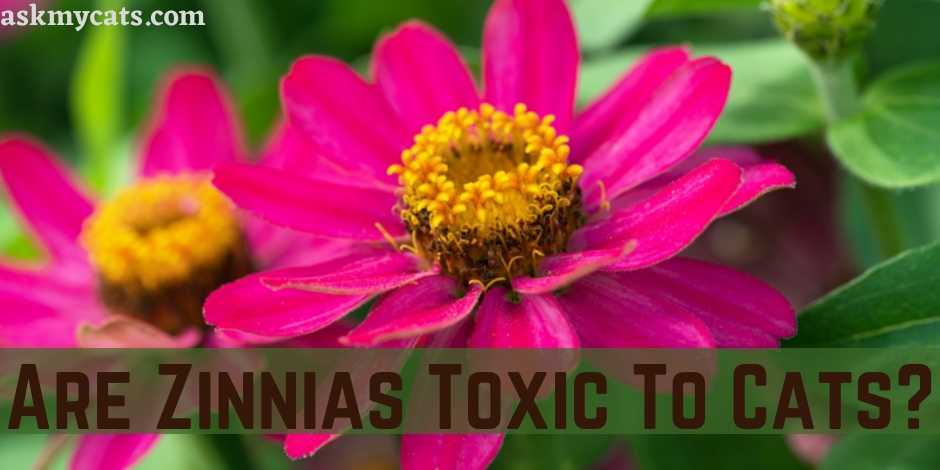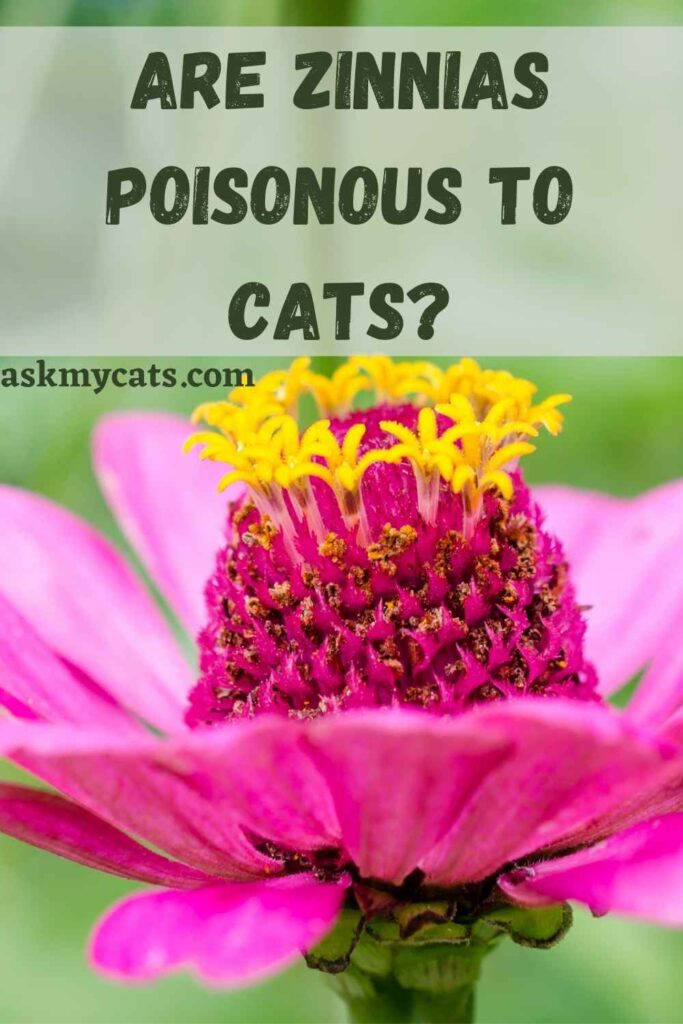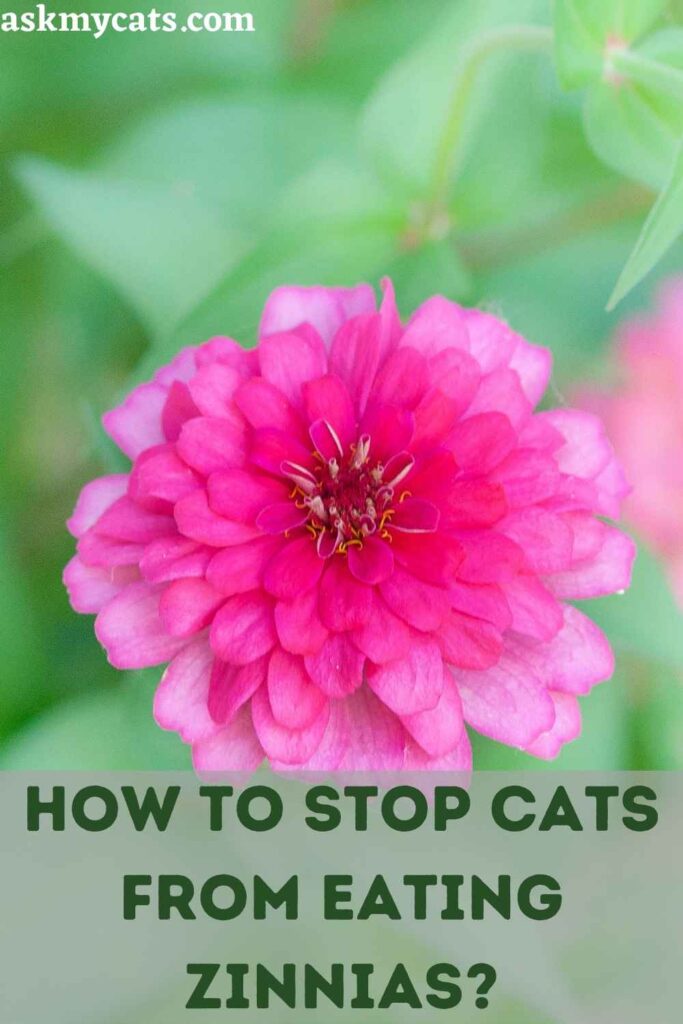Zinnias are a popular choice for landscaping and gardens, particularly among homeowners in warmer climates where the zinnia flower grows well.
You can leave them planted in your garden or flower beds around your house, or you can cut them and bring them inside for a lovely dining table centrepiece.
Zinnias are becoming increasingly popular as they produce bright and colourful flowers year after year. This growing popularity can be concerning for both parents and cat owners, as many plants in the world are poisonous to both humans and cats.
So, are zinnias toxic to cats?
No, zinnias are not toxic to cats. Zinnia plants are not poisonous to cats, according to the ASPCA. Having said that, it’s still important to keep your cat away from your zinnias as much as possible.
This article will tell you more about the relationship between zinnias and cats and how can they co-exist.


Give Your Cat the Perfect Day
Get the Free Ebook!
What Are Zinnias?
Zinnias are a genus of plants of the sunflower tribe (Heliantheae) within the daisy family (Asteraceae).
Zinnias are endemic to scrub and arid grassland in a range of climates from the Southwest to South America, with Mexico serving as a diversity hotspot.
The genus is known for its single long-stemmed flowers, which come in a variety of vibrant hues. Johann Gottfried Zinn, a German renowned botanist, is honoured by the genus name.
Zinnias are annuals, shrubs, and sub-shrubs native to North America, with a few species native to South America.
Although most species have upright stems, some have a slack habit of spreading stems that heap over the ground’s surface.
They usually stand between 10 and 100 centimetres tall (4″ to 40″). The leaves are opposite and frequently stalkless (sessile), varying in shape from linear to oval, with a pale to medium green hue.
The flowers come in a variety of shapes and sizes, ranging from a single row of petals to a dome.
Zinnias come in a variety of colours, including white, chartreuse, yellow, orange, red, purple, and lilac.
Zinnias are easy to grow and can produce large, colourful blooms.
Their petals can be a single row with a visible centre (Single-flowered zinnia), several rows with a centre that is not visible (Double-flowered zinnia), or petals that are somewhere in the middle with multiple rows but visible centres (Double-flowered zinnia) (Semi double-flowered zinnia). Their blooms come in a variety of shapes.
Are Zinnias Poisonous To Cats?
No, zinnias are not poisonous to cats.

Your outdoor landscaping helps you feel at ease by giving your home a bright, settled appearance.
However, the flowers and plants we choose to beautify our homes and give them flair can sometimes put our feline friends in danger.
There are a variety of plants that are poisonous to cats, and if you’re a homeowner wanting to plant a garden or landscape in your yard, it’s crucial to know which plants are poisonous to your cat or other cats in the neighbourhood.
So the question that often arises in the minds of cat-parents is “are zinnias poisonous to cats”.
You can rest easy knowing that cats are not poisoned by zinnias according to the ASPCA.
If you keep your cat outdoors, you might want to keep the majority of your outside plants and flowers in hanging pots that are harder for your cat to access.
While the plant isn’t toxic to your cat, it isn’t exactly healthy for him, and it may cause him to have stomach problems or diarrhoea.
Even while zinnias and other plants can provide a nice way to freshen up your home, if you keep your cat indoors, you may want to leave your zinnias and other plants outside.
This is simply a precautionary measure to keep your cat away from flowers, as not all flowers are suitable for him to eat.
If your cat becomes accustomed to eating zinnias and is not discouraged or disciplined, he may not be as cautious when confronted with a more poisonous plant species.
Even if your cat eats a zinnia, it’s still a good idea to get a professional evaluation from your cat’s veterinarian to be sure there’s nothing to worry about.
You should keep a check on your cat over the next few days for any negative reactions or unusual signs.
What To Do If Cat Has Ingested Zinnias?
If your cat ingested zinnias take her to the vet immediately.

In contrast to some of the more severe symptoms of plant toxicity, zinnias, notable plants of the tagetes species, produce relatively minor discomfort to the gastrointestinal tract when consumed in large quantities by cats or dogs, according to the Pet Poison Helpline.
While the toxicity of zinnias is considered minor in comparison to some of the most severe adverse reactions to a variety of hazardous plants, it is nevertheless caused for caution.
The amount of food consumed, as well as the cat’s health, age, and immune system status, may result in a more severe reaction than the average mild reaction.
It’s usually a good idea to contact an animal poison control centre, phone your veterinarian, or travel to a veterinary emergency facility so that your beloved cat can be properly assessed and treated.
Programming your phone with your veterinarian’s phone number, the phone number of the nearest emergency vet clinic, the 24/7 ASPCA Poison Control Center (888) 426-4435 (a consultation fee may apply), and the Pet Poison Helpline’s number 855-764-7661 will help you be proactive and prepared in the event of a pet poisoning emergency.
Pet Poison Helpline is a 24-hour, triple-licensed, independent animal poison control centre that helps pet parents in the United States, Canada, and the Caribbean.
When it comes to hazardous plants and cats coexisting, prevention is always the best approach.
The way your cat reacts to the consumption of zinnias will determine its therapy. Treatment may be influenced by the cat’s age and current health status.
Toxins in the zinnias will be more difficult to eliminate in cats with kidney problems. This could aggravate the illness, necessitating a new treatment plan.
The veterinarian’s therapy will primarily focus on reducing poisoning symptoms. Intravenous therapy will be provided to cats who vomit a lot to maintain their electrolyte and hydration levels steady.
This will aid in the removal of zinnias from the cat’s body by the liver and kidneys. Antiemetic medication may also be used.
After the fur and skin have been cleansed, a soothing ointment will be applied.
Do Cats Like Zinnias?
Whether a cat will like zinnias or not is completely dependent on the cat and its personality.
Zinnias are not among the common plants that cats detest or prefer. Planting zinnias in your home or garden will reveal this.
Examine the plant to check whether your cat is purring and walking about it. If that’s the case, your cat loves zinnias.
Can Eating Excessive Amounts Of Zinnias Be Harmful To Cats?
Humans, dogs, cats, and many livestock animals can be harmed by eating excessive amounts of the Zinnia plant, but they are unlikely to die.
The amount considered excessive will vary depending on the age and size of the animals or humans.
When compared to an adult or a larger animal, younger and smaller animals and people will require a smaller amount of the Zinnias plant to be regarded as an excessive amount, but an adult or a larger animal will require a fairly significant amount of the Zinnias plant to be negatively affected.
When a large amount of Zinnia’s plant is taken in one sitting, the animal or person will experience some unpleasant side effects, which should subside within a few hours.
How To Stop Cats From Eating Zinnias?
If you want to stop your cat from eating zinnias you can consider the following tips: –

1. Use Repellents Like Mustard & Pepper
Mustard is a wonderful cat repellent: simply dilute a few spoons in water and spray it on plants where your cat is wreaking havoc.
Then, using a spray, saturate the area with the repellent and repeat the process every 2 days or so.
Pepper is also effective at keeping cats away from your lovely plants.
To get the best results, use freshly ground black pepper or, if that’s not possible, a commercially purchased pepper mill. Then simply sprinkle your cat’s preferred plants.
The only disadvantage is that the pepper fragrance does not remain long. As a result, you’ll need to sprinkle on a regular basis to keep your cat away from your plants.
You can alternatively dissolve two tablespoons of crushed fresh pepper in a cup of hot water, let it sit for a few minutes, then thoroughly combine everything before filtering. Then, using a spray bottle, squirt the solution.
2. Use Of Citrus Repellents
Lemon and citrus fruits in general are disliked by cats (like orange or tangerine). While essential oils such as orange and lemon can be toxic if overused, using a DIY zest repellant is harmless.
Bring a litre of water to a boil with lemon or orange zest, then infuse for ten minutes before filtering.
Spray the finished mixture around the house once it has cooled. Repeat the procedure as needed — bonus, it smells delicious!
3. Use Essential Oils
To keep cats away from your plants, use any citrus essential oil (orange peel, lemongrass, lemon, tangerine).
Essential oils, on the other hand, must be used with caution because they can become hazardous if used in excess.
As a result, you must dilute them in water, for example, five drops of lemon zest essential oil in 500 ml of water.
Essential oils of lavender and eucalyptus are also good natural repellents, but they can also be hazardous.
Furthermore, if your cats or plants are eating them, never spray directly on them! Instead, in your jars, insert a cotton ball soaked in a few drops of essential oil; this will keep your cat away without putting him in danger.
4. Use Coffee Grounds
This is a simple trick to perform. Coffee grounds can also be used as a fertilizer for your plants.
Collect your coffee grinds in a container and set them at the base of the plants or flowerpots you’re working with.
Repeat as needed to keep the gadget working properly, and discard the grounds if they begin to mold.
5. Use Onion & Garlics
Simply brush the edge of the tubs with a fresh onion cut in half to preserve your blooms! However, because the fragrance is strong, you may want to avoid employing this approach inside your home.
However, it may be useful to your balcony’s plants or flowers. Garlic cloves, sliced in half, can also be placed directly in the pots of your plants. Cats will be scared away by their fragrance!
Frequently Asked Questions
Are zinnias toxic to humans?
Zinnias are non-toxic to humans and are one of the numerous edible plants that can be consumed without risk. There are various recipes that call for the petals of the Zinnias flower. Despite the fact that the entire Zinnias plant is edible, the petals are usually the only portion utilized in cooking, and they are reported to have a harsh flavour. You should not be concerned if your child or a member of your household eats a piece of Zinnias plant.
What Animals Are Attracted To Zinnias?
Zinnias are excellent pollinators during the growing season, from May to October, due to their high pollen concentration. They also attract ladybugs, Japanese beetles, hummingbirds, and wasps.
Final Words
Zinnias are popular among gardeners because they are both attractive and simple to grow. They provide your house and landscape with a splash of colour.
The best aspect is that they are completely safe for cats and other pets. Your cat should be okay around the flower as long as she doesn’t devour large amounts at once.
Ask us questions in the comments section if you have any.
